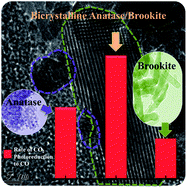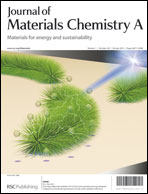Among the three naturally existing phases of TiO2, brookite is the least studied as a photocatalyst. In this study, single-phase anatase and brookite, and mixed-phase anatase–brookite TiO2 nanomaterials were synthesized through a hydrothermal method. The anatase–brookite phase content was controlled by adjusting the concentration of urea in the precursor solution. XRD, Raman spectroscopy, and high-resolution TEM were used to confirm the crystal structures. SEM and TEM analyses demonstrated that anatase TiO2 were nearly spherical nanoparticles while brookite TiO2 were rod-shaped nanoparticles. UV-vis diffuse reflectance spectroscopy showed a blue shift in absorption spectra with increasing brookite content. The photocatalytic activities of the prepared bicrystalline TiO2 were evaluated for CO2 photoreduction in the presence of water vapor for production of solar fuels (CO and CH4). The activities were compared with those of pure anatase, pure brookite, and a commercial anatase–rutile TiO2 (P25). The results showed that bicrystalline anatase–brookite was generally more active than single-phase anatase, brookite, and P25. The bicrystalline mixture with a composition of 75% anatase and 25% brookite showed the highest photocatalytic activity, likely due to the enhanced interfacial charge transfer between anatase and brookite nanocrystals. In situ DRIFTS analysis showed that CO2− and HCO3− species were active reaction intermediates for CO2 photoreduction while the accumulation of non-reactive CO32− species on the TiO2 surface may be detrimental.

This article is Open Access
 Please wait while we load your content...
Something went wrong. Try again?
Please wait while we load your content...
Something went wrong. Try again?


 Please wait while we load your content...
Please wait while we load your content...